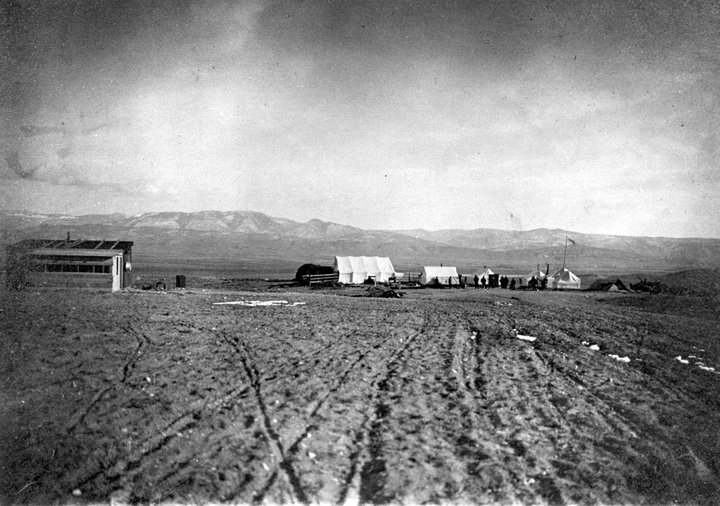The Jewish Agricultural Colony of Clarion, Utah, 1911-1916
During the late nineteenth and early twentieth century, there were several attempts to established Jewish agricultural colonies in the United States.
The movement, headed by recent immigrants and established backers, sought to settle predominantly Russian Jews on farmlands in Oregon, Colorado, the Dakotas, Michigan, Arkansas, Virginia, New Jersey, and elsewhere, thereby repealing the constraints of Eastern Europe, which limited Jews to petty commerce and denied them land ownership.
In 1911, a small agricultural colony was established in Clarion, Sanpete County, Utah under the leadership of Ukrainian Jewish immigrant and social idealist Benjamin Brown.
At the time, Utah was marketing its farmable land through a large-scale advertisement campaign and its Bureau of Immigration, Labor and Statistics, which disseminated materials to prospective migrants throughout the country.
Jewish Agricultural and Colonial Association
The idea for the Jewish colony was hatched at a meeting in Philadelphia on January 10, 1910, involving 150 Jews – 95 from Philadelphia and 55 from New York. The group organized the Jewish Agricultural and Colonial Association (JACA) with Benjamin Brown as its president.
Other guiding forces included Joseph Miller and Benjamin Fruckerman, graduates of the Baron de Hirsch Farm School, the school’s president Joseph Krauskopf, and Rabbi Isaac Landman of the school’s executive board.
JACA purchased 6,085 acres of public land in Sanpete County at an auction in August 1911. The price was $11.20 per acre, plus an additional $35.00 per share of water in the Piute Canal. One-tenth of the purchase price was required as a down payment. The balance was to be paid over ten years at an interest rate of five percent.
The initial plan was to settle roughly 200 families on the colony, with the number eventually growing to 1,000 families.
JACA, the farm school, and the Jewish Agricultural Aid Society promoted the colony to wealthy backers, including Samuel Newhouse of Salt Lake City, a mining man and financier who gained the support of Utah’s Governor William Spry.
Clarion, Utah
Within a month of the purchase, twelve pioneers were sent to Clarion to prepare the land for the larger migration. By Spring 1912, 1,500 acres had been cleaned, plowed, and planted with wheat, oats, and alfalfa.
By September 1912, the colony had grown to twenty-three heads of family, eleven wives, twenty-two children, and four single men. Children of the family men were expected to join the colony, and plans were made to settle fifty-five more families.
However, the mostly poor Russian immigrants were ill-suited for the type of agriculture they encountered under irrigation. The majority of applicants were laborers or tradesmen of various kinds. Just one of them, twenty-six-year old Harry Tucker, had actually been a farmer back in Russia.
The colony faced difficulties from the start. The quality of the soil varied from plot to plot, and there were periods of severe weather and dust storms. Furthermore, whereas earlier Utah pioneers found land and water for the taking, the Jewish settlers were immediately faced with debt.
Harvests did not yield enough to pay off the title, outstanding balances, or the high-priced irrigation system. Unable to find sufficient financial support in Utah, Brown traveled East with a letter from Governor Spry. He convinced Julius Rosenwald of the Sears Roebuck Co. in Chicago to purchase half of the unsubscribed bonds issued by the Utah Colonization Fund, which had assumed the assets of JACA.
Such contributions, along with more bountiful harvests, enabled the colony to hold on. However, by 1913, despite the best efforts of Brown, Spry, and other Utah officials, JACA pulled its support for the colony and discontinued further migration to Clarion.
On November 5, 1915, the State Land Board declared the forfeiture of all certificates of sale and proposed water contracts. A few wealthy Utah Jews, including Simon Bamburger, assisted colonists with funds for returning East or settling elsewhere in the West.
On January 18, 1916, the lands of the Clarion Jewish colony were offered for sale at a public auction.
Source
- Everett L. Cooley, “Clarion, Utah: Jewish Colony in ‘Zion,’” Utah Historical Quarterly 36/2 (1968)
- Jerry Klinger, “The Jewish Farming Settlement of Clarion, Utah: The Impossible, Impossible Dream,” Western States Jewish History 48/2
Thank you to Judy Perry for bringing this story to our attention.
